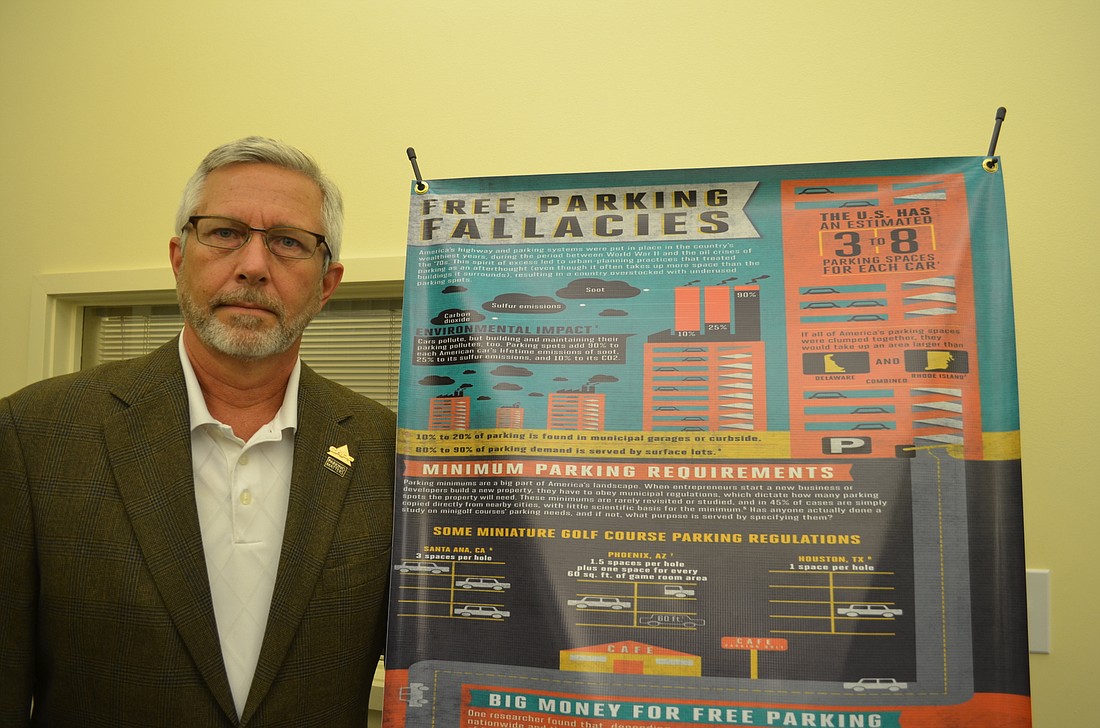- December 18, 2025
-
-
Loading

Loading

Although he says he’s excited to have a frank discussion with commissioners and residents, Mark Lyons knows he’s in a precarious position. Given the issue at hand — parking, in the city of Sarasota — one wrong step could set off a landmine of public outcry.
There’s likely a reason that a comprehensive examination of parking management has failed to make the City Commission agenda for the past four years. A citizen committee tasked with discussing that subject finished its work in November 2014, and the group’s analysis has more or less gone unrecognized among policymakers.
It’s a fact that the last significant parking policy endeavor — the installation of parking meters downtown in 2011 — went poorly. In the eyes of the public, it failed resoundingly. The meters were hard to use. Merchants got so mad that they showed up to meetings with bags on their head. City officials gave up a year after the project began.
“Ignoring it doesn't help our community — it does just the opposite.” — Mark Lyons
Lyons, who was hired after the meters were installed but before they were removed, is acutely aware of this history. That’s why he’s cautious when talking about the forthcoming discussion of a citywide parking management strategy — but yes, he’s also eager to confront the topic.
“Parking’s been a sensitive issue for many years, and as we continue to grow, ignoring it doesn’t help our community,” Lyons said. “It does just the opposite.”
On Monday, Lyons will present the Citywide Strategy for Parking Management to the City Commission. The document is a culmination of more than two years of work by the Parking Advisory Committee, a group comprising representatives from various districts facing parking challenges.
For the general public, the 73-page report (335, including the appendices) will likely boil down to one takeaway: Paid parking is coming back. Lyons is resigned to that reality, but he wants people to know the document is more than just a wordy justification for reinstalling the meters.
The report discusses several other subjects. Exploring car-sharing opportunities could reduce the need for more parking spots. A more robust employee parking program could open up premium spaces for visitors, rather than workers. A residential parking permit program could lessen the burden on people living in neighborhoods adjacent to shopping districts like St. Armands or Southside Village.
“My hope out of all of this is that parking is seen as a service to the community, and not just a headache,” Lyons said.
One priority is to make parking more user-friendly — by, say, reducing backups caused by drivers hunting for parking on Main Street. Lyons and the committee want paid parking revenue to benefit the communities in which those meters are located, a major selling point for some merchants who have changed their stance.
“The smartest thing I ever heard about on-street parking is you take the money that is gained from that block and use it in that block,” Downtown Improvement District Chairman Mark Kauffman said after the DID endorsed on-street paid parking earlier this year. “And all of a sudden, store owners were OK with it.”
But there are real financial considerations, too. The parking management division requires hundreds of thousands of dollars in general fund subsidies annually. Eliminating that gap is an important part of running a sustainable program, too.
The recommendations outlined in the strategy report work to address both of these issues. The document theorizes that paid parking can do more than generate revenue — it gives drivers more options, stimulates business and encourages turnover in high-demand spaces.
Not everyone will be happy with the changes, but the goal is to provide an overall benefit for the general public.
“It makes no sense that before stores are even open, the streets are full,” Lyons said. “We have to manage the spaces, manage the behaviors of people parking downtown so it benefits our businesses and people who want to park.”
Already, the committee’s work has shown signs of paying off. Five years ago, the St. Armands Business Improvement District and DID were steadfastly opposed to paid parking in their commercial neighborhoods.
Today, the BID has already committed to accepting paid parking on the Circle, and the DID has asked why the city’s isn’t taking a more proactive approach when dealing with the issue.
Four years out from the first parking committee meeting, Lyons says the deliberate pace of implementation has come with some advantages — one of which has been an evolving community attitude on paid parking. He doesn’t want parking to go unaddressed, but even if everything moves ahead without incident, it’ll likely be at least a year before the first meters are installed.
Throughout this process, Lyons has been focusing on building consensus. If the commission approves the parking strategy document, he’ll ask to reconvene the parking committee to explore the details of implementation in each district. That way, the city can continue to draw on neighborhood feedback as it works to avoid the pitfalls of the past.
“We don’t want to get ahead of ourselves and approve things without community input — which is what happened last time,” Lyons said. “That bred discontent with the system, so we want to be careful with that.”